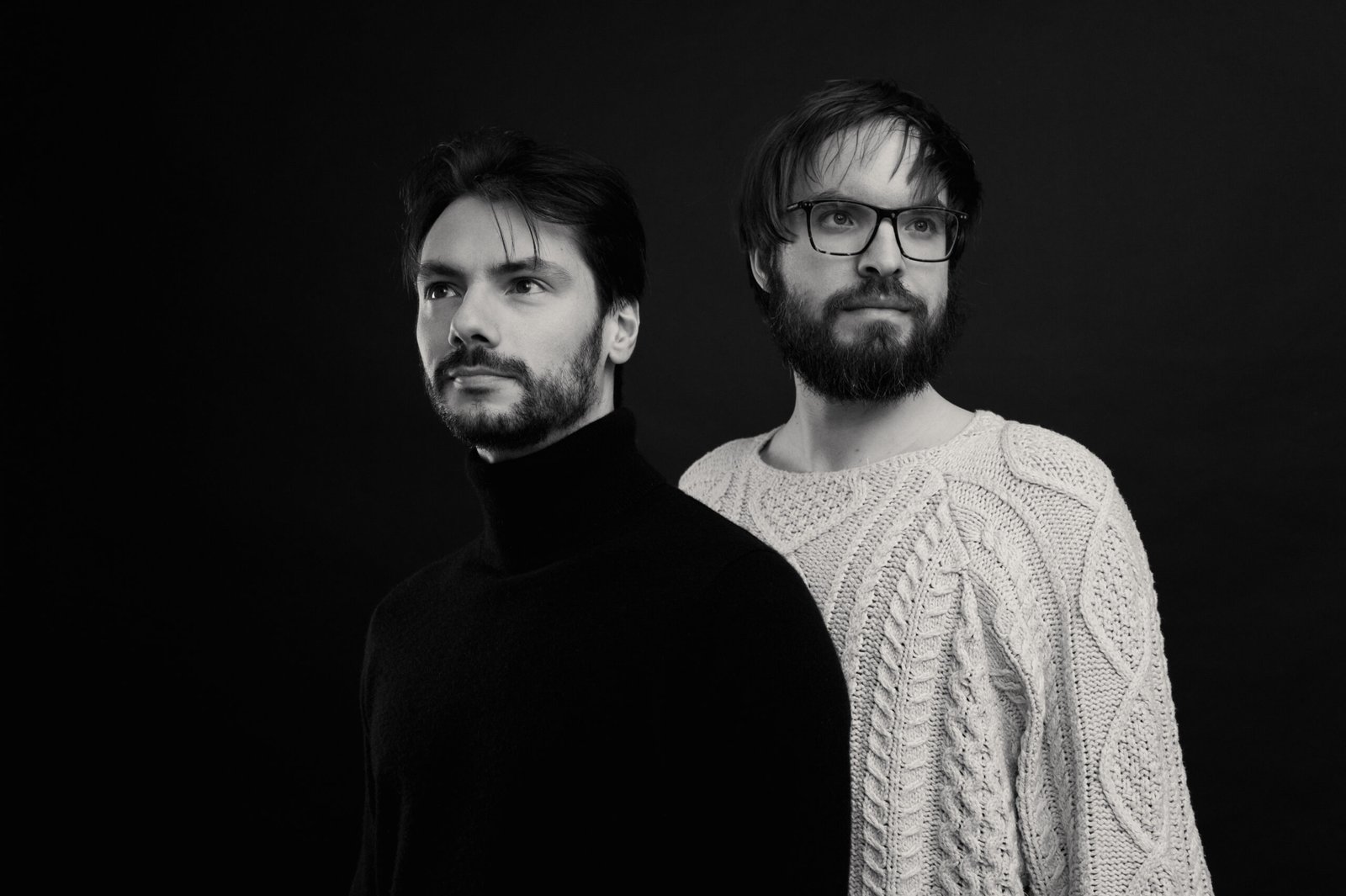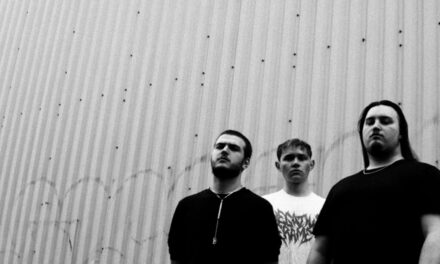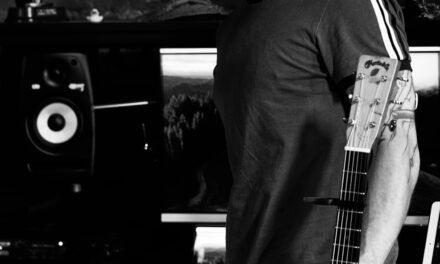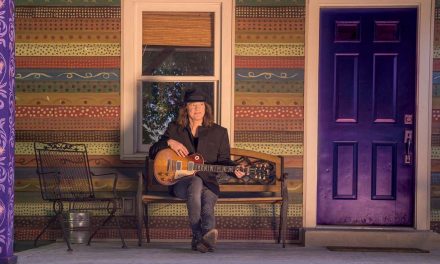Michael Künstle & Matteo Pagamici Talk New Album


Words by Glenn Sargeant
Feature Image Photo Credit: Supplied By Prescription PR
Michael Künstle & Matteo Pagamici have recorded their forthcoming album ‘DIMENSIONS’ at Abbey Road Studios with a 92-piece traditional orchestra. The duo kindly talked to us at JLTT about the new album:
How and when did you both meet?
MP+MK: We met in university during our studies at the Zurich University of the Arts. We
both did our BA and MA in film scoring there. However, our collaboration started only a few
years after graduating, when we both were in our early stages of our careers. The first
project we did together was the Swiss drama series NEW HEIGHTS, which was the first
Swiss tv production to be sold to all Netflix countries. There we discovered our common
passion for experimenting and sampling, and how well our two very different musical
languages can meet.
What is your earliest musical memory?
MP: My parents owned a CD from the Chinese folk music duo GUO BROTHERS. They
had heard them perform live during their honeymoon in the early 90s and brought home a
record. For some reason, that music hooked me immediately and I listened to it non-stop
when I was 4 years old. I can still remember every musical detail and I believe that it
sparked a love for folk music and ethnomusicology in me, since it’s something that still
deeply fascinates me.
MK: My father used to play in a band when I was little and they’ve recorded a lot of songs
on cassette. I used to listen to them all the time. Especially when we were away from our
parents on vacations with our grand parents.
When did you begin composing music?
MP: In Switzerland, all kids have the opportunity to learn an instrument starting from the
age of 8. Originally I wanted to play the harp, but we couldn’t find a teacher, so I opted for
the guitar, which at the time felt like a tiny harp with fewer strings. I started composing
almost immediately, it just felt like a natural part of learning and playing music.
MK: I started making music my father when I was nine. He played the guitar and sang and
I was playing the drums. I suddenly understood that I could compose my own music
instead of playing the music from other people.
You have your new album ‘Dimensions’ released on 8th August 2025. How did
you want to approach the making of the album?
MP+MK: A lot of what happens in DIMENSIONS is the product of experimentation and
exploration of musical material during our work on film and tv scores. Because there were
so many unused ideas, we had the plan to make our own album for a long time. The
enthusiasm for experimentation really represents the musical core of the music. We spent
a long time discussing what we wanted to express, what ideas we wanted to pursue
further, what the underlying storytelling concept was.
Where did you record the album and who produced it?
MP+MK: We recorded the album at Abbey Road Studios. ISBJERGE and ABSTRACT 2.0
were recorded in Studio 1 with a 92-piece orchestra, the other tracks with a smaller
ensemble in Studio 2. We had a very clear vision of how the music should sound like, so
we produced it ourselves. However, the inputs of our recording engineers Nick Wollage
and Daniel Dettwiler were incredibly helpful, as were the broad experience of our
conductor Anthony Weeden.
We chose Abbey Road not only because of how excellent the
rooms sound, but also to be able to work with London’s top musicians and get the very
best out of the performances. This combination of talent really made the difference, I don’t
think we could have recorded the album anywhere else and achieved the same result.
Do you have any interesting, funny or memorable stories from the recording
sessions?
MP: Every second at Abbey Road is memorable. But hearing the very first performance is
always so mind-blowing. It exceeds any expectations and really lets you hear the music in
a way you didn’t know it could exist. Those first few seconds always hit so hard, and it’s
not something I could ever get used to.
For FIREFLIES we asked the musicians to whisper during the performance. It’s something
we had experimented with in our studio in Basel before, and it added a very ethereal
aspect to the music, something that couldn’t have been achieved if we had just added
whispering afterwards. But it was something that the musicians hadn’t really done before
and it was quite funny and unusual. As soon as the recording stopped, everyone started
laughing – but if you listen to the track, the whispering is subtle and really works, in my
opinion.
MK: For me the sessions at Abbey Road feel always the most relaxed and the most
focused at the same time. The mentality, musicianship and spirit of collaboration is just
incredible.
My funny moment with both session was that for some reason I couldn’t finish two of the
last pieces long enough before the session even though I worked on them for weeks. And
so I finished FREEDOM TO LIVE and ABSTRACT 2.0 really at 5am on the morning of the
session. A lot of people at the session liked those two pieces the most and I’m still not sure
if that should make me happy or not.
Did you use any particular instruments, microphones, recording equipment to
help you get a particular sound/tone for the record?
MP: Abbey Road’s vintage mic collection is a paradise. For the bigger line-up in Studio 1,
part of what really defines the sound is the position of the musicians within the space. The
Violin I and II are panned left and right, the percussionists are sitting near the walls all
around the room in a circle, and there are two harps sitting on opposing sides as well. We
tuned one harp one quarter tone lower, which opens a whole new world of sounds!
For the smaller ensemble in Studio 2, we chose to have an unusual amount of space
between the players, much more than you would normally have. That makes the sound
less homogeneous, you can really hear and feel every single musician and the space
becomes much wider. It made sense because for most tracks we wrote a separate voice
for everyone, so we really want to bring out the soloist aspect.
After the recording, we mixed the music with our engineer Daniel Dettwiler. He’s very
enthusiastic about analog outboard gear and has a massive collection. We processed the
album through his original Cadac console that was used for Bohemian Rhapsody. We
were aiming for a good balance between a timeless sound and the analog warmth and
depth.
Which of your new album tracks hear you at your a) happiest, b) angriest and c)
most reflective?
MP: Reflective definitive applies to all of them, maybe in different aspects. The angriest
one is maybe LOVE LETTERS, where we experimented with really dark playing
techniques such as chaotic aleatoric lines or distorted notes to emulate white noise in an
acoustic setting. The title is obviously ironic and sets a very different expectation, which is
something we wanted to play with when the audience goes through the tracks.
I don’t know if there is a track that I would call the happiest, maybe for me it’s FIREFLIES.
Although it’s nostalgic, it features an almost child-like curiosity and mysticism that I find
deeply relaxing.
MK: I would say the angriest in tone is BRUTALIST even though the inspiration for the
piece didn’t come from an angry emotion, but from the reflection on brutalist architecture.
What fascinated me was the idea to make something beautiful out of something raw and
ugly. The piece also explores the typical rectangular shapes that we know from this type of
architecture.
The most reflective for me is definitely CHILD WISH which reflects on the struggles from
my wife and myself and our wish to become parents.
The physical vinyl comes with a book to broaden the listening experience. When
did you have the idea for the book and did you work with any particular writers/
illustrators/photographers?
MP: Travel was a huge part of inspiration for the storytelling aspect of our music in
DIMENSIONS. A lot of our music is inspired by the environment we’re in, and I’ve just
started to discover how much it affects me and how many different ideas it can bring out.
That’s why we wanted to broaden the listening experience and add a visual element to it.
We also wanted to make it as personal as possible. We wrote the texts ourselves, they’re
diary entries from the moments and memories that inspired each track.
Most of the photographers were taken by me in the places that inspired the music (and some others
by Kim Leuenberger, who is a very gifted travel photographer and good friend of mine). In
a way, the photographs and texts help to contextualise the music and its origin – you can
read and see its background and origin story while listening. We want to take the audience
on the same emotional journey that sparked our inspiration.
MK: When I was a teenager I discovered that when I listen to a record up and down during
my travels, I could „save“ my memories within the music I was listening to. I am still
fascinated by that fact and most of the music of that time still takes me back to those
memories. This was pre iPod era and a great way to truly get to know a record anyways.
When we talked about it with Matteo it turned out that we shared this relationship of music
and travel.
DIMENSIONS is the attempt to turn that process upside down. Now, our memories are
saved within those tracks and ready for the listener to add theirs.
Was it a difficult album to write?
MP+MK: In a way it was the easiest work we’ve ever written. It felt incredibly natural and
we barely had any notes to give each other. When we work on film scores, we’re often
very critical and it can take multiple round of revisions to really bring the music to the level
we want it to be, but here it all fell into place immediately.
At the same time, the most challenging aspect was that we’re writing music just for
ourselves, not for a film or a tv show. We aren’t telling anyone else’s story, we’re telling our
own. That required an unusual amount of reflecting and conceptualising. It was an unusual
process and it took some time and energy to really get into it. But a process we found so
much joy in that we can’t wait to write and record our next album.
Who designed the album artwork?
MP: The album artwork featured a lonely iceberg from above, in the sea near Ilulissat,
Greenland, surrounded by fog and clouds. I took it a few years ago during an expedition in
that area. It sums up the concept of the album perfectly, because at first glance you can’t
quite tell what it is, how big it is, or where it is.
Do you have any visualisers planned to accompany the album?
MP+MK: We have a few videos lined up for some of the tracks, to add a further visual
dimension, especially for the audience that doesn’t own our book.
Where is your hometown and could you please describe it in five words?
MP: My hometown is Zurich, Switzerland. I was born here, although my parents
immigrated from Italy. It’s cozy, safe, small, exciting and routined all at the same time.
MK: I’m from Basel, Switzerland. I was also born here, but my mother is from Poland and I
always had a great connection to that country, too.
In adjectives I would describe it exactly as Matteo described Zurich. As a sentence in 5
words I would say: Basel is Roger Federer’s hometown.
Do you have any particular warm-up techniques or processes?
MP: It’s a process that I’m still trying to figure out. There are a lot of things that can
influence the way I write music, especially the environments I find myself in. But I don’t
have a routine that always leads me to the results I’d like. It’s more, I always try to look for
something new, and that’s what allows me to discover something new in music a well.
MK: The routine I have to take care of most is going for a walk and drink a Cappuccino at
my favourite coffee maker. That’s my number one fuel for ideas. It’s important to get your
head clear of any thoughts.
Often when the work schedule gets tight I ditch the walk to have more time for the writing.
And I think surely I’ll be fine, I was so inspired the last days. But of course I’m wrong. The
quality work I’m able to then is much less and everything takes more time to finish.
Do you have any live dates planned in the UK/Europe in 2025/2026?
MP+MK: Not so far, but we are looking into opportunities to perform DIMENSIONS or part
of it live. Mainly here in Switzerland for now, but hopefully also on a more international
level if possible.
What two things do you hope to have achieved once you have left the stage?
MK: My dream is to have our music performed at The Royal Albert Hall and to have
scored a culturally significant movie.
You are given the opportunity to write the score for a film adaptation of a novel
that you enjoy. Which novel is it and why?
MP: The first things that comes to mind is THE SHADOW OF THE WIND. I would love to
see a film adaptation of that and write music that is as magical as the story being told.
MK: 1984 by George Orwell, because the topicality is so frightening.
You wrote parts for every single musician involved – A 92-piece orchestra and
24 assembles musicians for the album recording. How did you break this down?
MP+MK: A lot of it had to do with scale. We experimented with melodies being played by a
single musician, or by three musician, or by fifteen. Writing for every single player also
gave us full control over the space, we could precisely define where we want the sound to
come from.
As for the physical orchestra score, there were so many staves that for ISBJERGE the
printer didn’t have enough resolution and some of the small texts weren’t readable for the
conductor!
What two pieces of advice do you have for a novice composer?
MP: Be curious and keep looking further. I see a lot of novice composers trying to emulate
the style of their idols, and while there is nothing wrong with that, if that’s all you do, you
end up sounding just like them without developing your own voice. It’s hard to develop a
unique voice if you don’t absorb a large variety of impressions, maybe even some that
don’t come from music.
MK: Write as much music as you can and have fun with it. Once you wrote it question your
hearing and your writing: Figure out how to write what hasn’t been heard before.
Who are some of your musical influences? Do you have any recommendations?
MP: I’m really fascinated by folk music!
MK: I’m a listener of everything. I can switch from contemporary classical music to EDM to
experimental rap in no time and find similarities that will inspire me for something in my
own work.
I’ll give you a recommendation for each of those genres. „Toro Takemitsu – Rain Spell“,
„Zedd – Shanti“, „clipping. – Story 2“.
What makes Matteo Pagamici and Michael Künstle happy and what makes you
unhappy?
MP: Music, good coffee, mountains, the sea and the Arctic make me really happy. No
coffee and no sleep make me unhappy.
MK: Music, movies, concerts, good coffee, family, friends and the beach make me happy.
Very few things can make me unhappy, but no sleep and no coffee is definitely on that list,
too!
Feature Image Photo Credit: Supplied By Prescription PR
Michael Künstle & Matteo Pagamici’s new album ‘DIMENSIONS’ is released on Friday 8th August 2025.
Purchase Here: https://dimensions-album.com/




